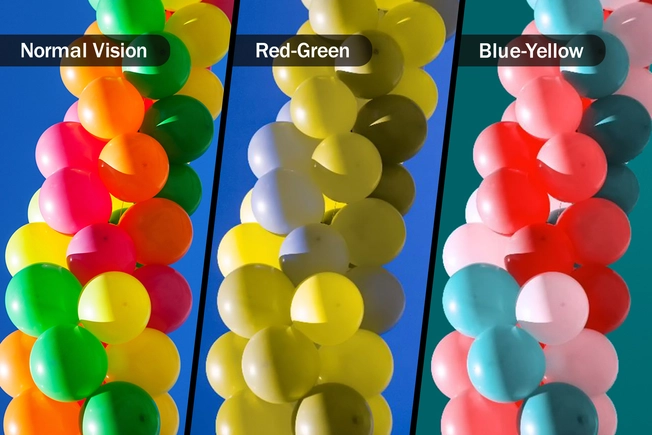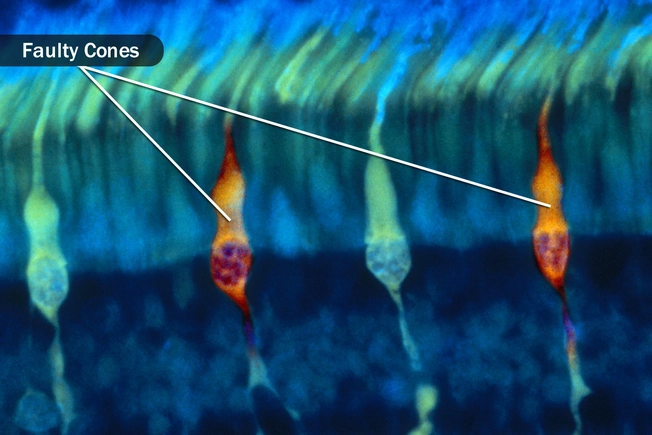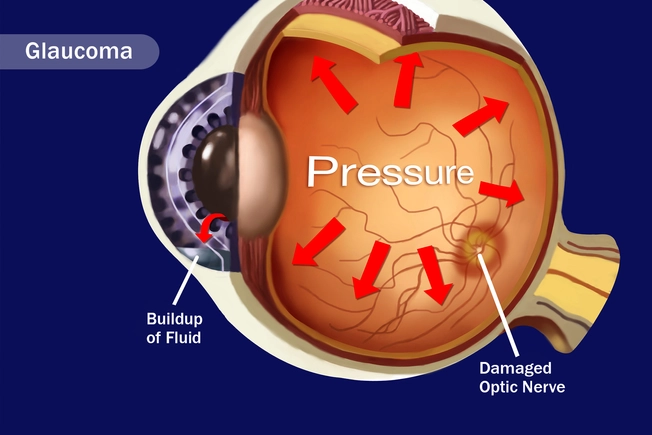Guide to Colorblindness
Αχρωματωψία / Δυσχρωματωψία
Τι είναι η αχρωματοψία;
Αχρωματοψία είναι η αδυναμία της αντίληψης των χρωμάτων. Δεν αποτελεί κάποια
μορφή τύφλωσης αλλά όταν έχετε αχρωματοψία, έχετε δυσκολία να ξεχωρίσετε κάποια
συγκεκριμένα χρώματα, όπως το κόκκινο και πράσινο ή το μπλε και κίτρινο. Η
αδυναμία αντίληψης του κόκκινου-πράσινου είναι η περισσότερο συχνή μορφή
αχρωματοψίας. Λιγότερο συχνή παρουσιάζεται αυτή της αδυναμίας αντίληψης του
μπλε-κίτρινου χρώματος. Σε αντίθεση με αυτό που πιστεύει ο περισσότερος κόσμος,
είναι σπάνιο ένα άτομο που πάσχει από αχρωματοψία να βλέπει μόνο σε αποχρώσεις
του γκρι.
Οι τρεις κατηγορίες προβλήματος όρασης που προκύπτουν είναι η μειωμένη ευαισθησία στο κόκκινο φως (πρωτανωπία - protanomaly), η μειωμένη ευαισθησία στο πράσινο φως (δευτερανωπία - deuteranomaly), που είναι και η πιο κοινή μορφή αχρωματοψίας, και η μειωμένη ευαισθησία στο μπλε φως (τριτανωπία - tritanomaly), η οποία είναι και η πιο σπάνια από τις τρεις.
Είναι η αχρωματοψία κληρονομική;
Η αχρωματοψία μπορεί να είναι κληρονομική ή να προέρχεται από ασθένειες που
προσβάλουν το οπτικό νεύρο ή τον αμφιβληστροειδή.
Η επίκτητη αχρωματοψία προσβάλει μόνο το μάτι που εμφανίζει τo πρόβλημα και μπορεί να χειροτερέψει με την πάροδο του χρόνου. Οι ασθενείς με αχρωματοψία που οφείλεται σε άλλες ασθένειες συνήθως έχουν πρόβλημα στον διαχωρισμό τoυ μπλε ή του κίτρινου χρώματος.
Η κληρονομική αχρωματοψία είναι η πιο συχνή. Προσβάλει και τα δύο μάτια και δεν επιδεινώνεται κατά τη διάρκεια του χρόνου. Αυτός ο τύπος αχρωματοψίας ανευρίσκεται στο 8% των ανδρών και 0,4% των γυναικών. Η αχρωματοψία αυτή συνδέεται με το Χ χρωμόσωμα και σχεδόν σε όλες τις περιπτώσεις μεταφέρεται από τη μητέρα στο γιο της.
Η αχρωματοψία μπορεί να είναι μερική και ονομάζεται δυσχρωματοψία (επηρεάζει μόνο ορισμένα χρώματα), ή πλήρης (επηρεάζει όλα τα χρώματα). Η πλήρης αχρωματοψία είναι πάρα πολύ σπάνια. Αυτοί οι ασθενείς οι οποίοι παρουσιάζουν πλήρη αχρωματοψία συνήθως εμφανίζουν και άλλα οφθαλμολογικά προβλήματα.
Τι προκαλεί την αχρωματοψία
Η αχρωματοψία υπάρχει όταν κάποια συγκεκριμένα κύτταρα του αμφιβληστοειδούς, τα οποία κανονικά ανταποκρίνονται στο χρώμα, δεν αντιδρούν όπως θα έπρεπε.
Συνήθως, οι άνθρωποι που έχουν αχρωματοψία έχουν γεννηθεί με αυτήν και η αχρωματοψία εμφανίζεται συχνότερα στους άνδρες παρά στις γυναίκες. Η αχρωματοψία προκαλείται από ένα κοινό, συνδεδεμένο με το Χ-χρωματόσωμα γονίδιο με υπολειπόμενο χαρακτήρα. Aυτό σημαίνει ότι εάν έχετε αχρωματοψία και η μητέρα σας θα έχει επίσης αχρωματοψία ή θα έχει μεν κανονική όραση αλλά θα φέρει το γονίδιο της αχρωματοψίας.
Οι πάσχοντες από αχρωματοψία πατέρες περνούν το γονίδιο μόνο στις κόρες τους οι οποίες μόνο στην περίπτωση που και η μητέρα τους φέρει το γονίδιο της αχρωματοψίας, θα εμφανίσουν αχρωματοψία. To γήρας ή ασθένειες που καταστρέφουν τα αμφιβληστροειδικά κύτταρα σε πολύ ακραίες περιπτώσεις μπορεί να οδηγήσουν επίσης σε αχρωματοψία.
Θεραπεύεται η αχρωματοψία;
H αχρωματοψία δεν θεραπεύεται. Παρόλα αυτά, η διάγνωσή της από την πολύ μικρή ηλικία είναι πολύ σημαντική αφού κατά τη σχολική ηλικία ένα πολύ μεγάλο μέρος του διδακτικού υλικού βασίζεται στην χρωματική αντίληψη. Γνωρίζοντας το πρόβλημα, γίνεται ευκολότερο στο παιδί να αντιμετωπίσει μαθησιακές δυσκολίες οι οποίες βασίζονται στην αντίληψη των χρωμάτων. Ετσι, εάν το παιδί σας έχει αχρωματοψία, θα πρέπει να ενημερώσετε τον δάσκαλο ή τη δασκάλα του ώστε το μάθημά του να οργανωθεί με τρόπο ανάλογο προκειμένου να αντιμετωπισθούν σχετικές μαθησιακές δυσκολίες.
What Is It?
Colorblindness isn’t really what it sounds like. Most people with the condition can see some colors correctly but can’t pick out others. “Color deficiency” might be a better name. Whatever you call it, it’s more common in men than women. About 1 in 12 men are colorblind, compared with about 1 in 200 women

Two Main Types
With the most common kind of colorblindness, you can’t tell the difference between some shades of red and green. Other people have a type that makes you confuse certain shades of blue and yellow. Either one can be mild, moderate, or severe.

How You See Colors
Your retina is a layer at the back of your eyeball that’s sensitive to light. It has two kinds of cells: rods and cones. The rods work in dim light, and the cones react to brighter light. They both respond to colors. Their signals go through the optic nerve to your brain, where they’re combined to make all the colors in the rainbow. About 12% of women have an extra kind of cone that lets them see 100 times more colors than other people.

How Colorblindness Happens
If you’re colorblind, that means there's a problem with at least one kind of cone. Those cones could be missing, or they might pick up a different color than they should. For instance, some cones could have defective genteic coding for specific color sensitive chemicals. Either way, they can’t send your brain the right information. Since the cones also help you see the fine details of what you’re looking at, colorblindness might also make you see a little less sharply.

Why It Happens: Genes
Most people who have colorblindness are born with it. That’s because it usually begins with the genes you get from your parents. Those genes don't give your body the right instructions about how to make blue, red, and green pigments for your cones. Without the pigments, the cones can’t recognize colors.

Why It Happens: Disease
Colorblindness can affect some people who aren’t born with it. Certain eye diseases can lead to it, and it also can happen along with leukemia, Parkinson’s disease, Alzheimer’s disease, sickle cell anemia, or alcohol use disorder.

Why It Happens: Medicine or Chemicals
Certain drugs -- including some that treat heart disease, high blood pressure, erectile dysfunction, nervous ailments, or emotional disorders -- can have colorblindness as a side effect. Colorblindness also can come from working around chemicals like fertilizers or solvents. But while things like taking certain drugs or working with certain chemicals can cause secondary color deficiency, it is very uncommon.

How It’s Found
If your child is colorblind, you may not know it until they start to learn the names of colors. Or they may have a hard time in school with exams or homework that use color-coded materials. It’s a good idea to test kids’ color vision around age 4. If colorblindness runs in your family, have your child tested by an eye doctor.

How It’s Diagnosed
The main way to tell if someone’s colorblind is the Ishihara color test. It uses images of dots in many colors. If you see color correctly, you’ll spot a number or some other shape in each image. If you’re colorblind, you won’t be able to. You can get the test to use on yourself, but an eye doctor can do it better.

Living With It: Gadgets
Apps for your cellphone or tablet computer can tell you what color something is. You take a photo, and when you tap on a place in the image, the app tells you the color. Some apps can even tell shades of colors. If you have red-green colorblindness, special lenses may let you see colors more clearly, although their effectiveness is widely controversial. For instance, special lenses to correct for color deficiency are not permitted for pilots.

Living With It: Habits
If you’re colorblind, it can help to ask someone to help you put labels on your clothes that tell you what color they are, so you can choose things that match. Arrange your closet so that clothes you can wear together hang close to one another. You also might memorize the order of colors in various objects, like traffic lights.

Is It Treatable?
If your colorblindness started because of a disease or is a side effect of prescription medicines, you might be able to do something about it. For example, your doctor might be able to prescribe a different drug. But the main kind of colorblindness, the type you inherit from your parents, can’t be corrected.

Working Toward a Treatment
Researchers are looking for ways to treat the kind of colorblindness you get through your genes by helping the cones work better. Tests on animals have been promising, and tests on people, called clinical trials, are going on now. Talk with your eye doctor if you’re interested in taking part in a trial.
Medically Reviewed by Whitney Seltman, OD on November 30, 2022
Sources © 2022 WebMD, LLC. All rights reserved.


Δεν υπάρχουν σχόλια:
Δημοσίευση σχολίου